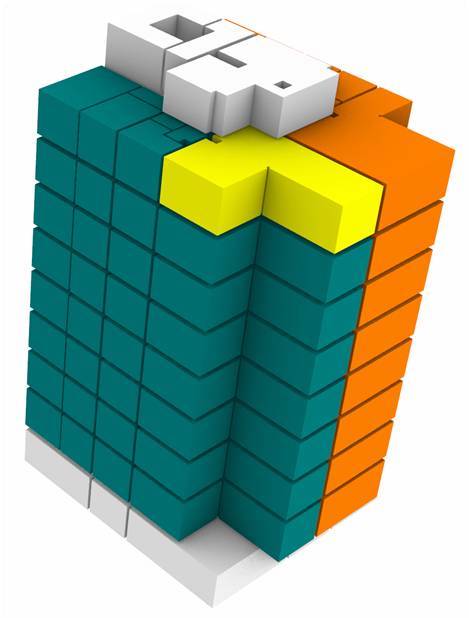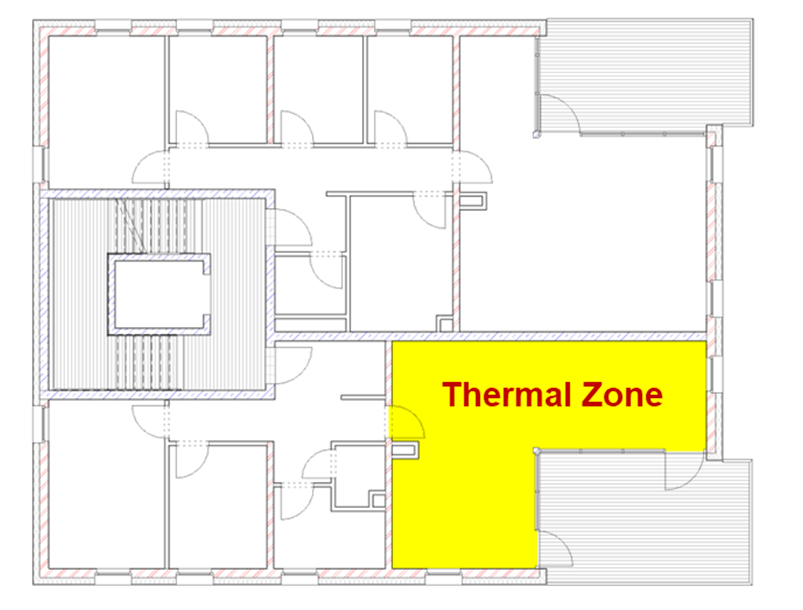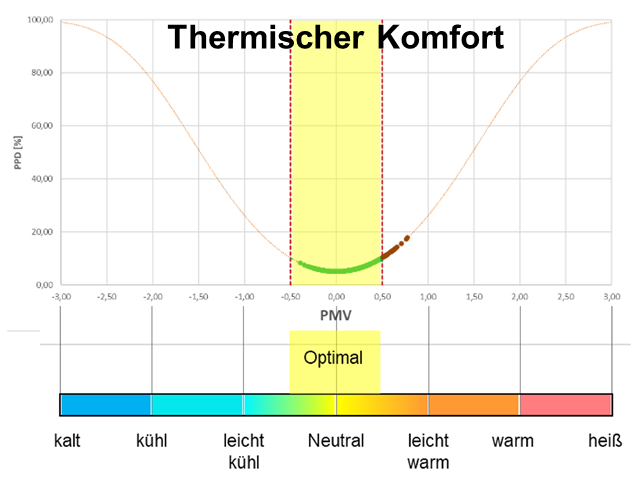Thermal comfort simulation in accordance with DIN EN 15251, ISO 7730, ASHRAE 55 for DGNB, LEED, BREEAM and WELL projects
We create the thermal comfort simulation of the operative temperature and the radiation temperature asymmetry for your building in accordance with DIN EN 15251, ISO 7730, ASHRAE 55.2010 for DGNB, LEED, BREEAM and WELL projects.
Kontaktieren Sie unsThermal comfort simulation for DGNB, LEED, BREEAM and WELL certification
We investigate the interaction of these components by means of thermal simulations that map the entire course of the year, taking real weather data into account in the early planning phase.
The investigation by means of a thermal simulation offers you an economical way:
- Planning reliability for thermal comfort/comfort in buildings,
- Planning reliability for system dimensioning,
- Decision-making aid for comparing variants when designing buildings,
- Optimization of existing building/control concepts.
Carrying out a thermal comfort simulation also helps you to meet additional criteria and gain points for building certification. We have listed the relevant criteria for you further down on this page.
We provide the following services for our clients to fulfill the criteria for DGNB, LEED, BREEAM and WELL certification:
- Illustration of the building (geometry and components) and the planned system technology in the simulation program
- Illustration of the usage profile
- Simulation and evaluation of the simulation data
- Documentation basics and results
- Presentation of the results
The PMV and PPD values are used as benchmarks for evaluating the values in the following certifications. The PMV value (Predicted Mean Vote) predicts the average temperature sensation of a larger group of people in a defined room.
The PPD value (Predicted Percentage of Dissatisfied) makes a quantitative statement about the well-being, i.e. the thermal comfort, of a group of people in a specific thermal environment.
It is important to note that even with a PMV of 0, around 5% of people in a group will still be dissatisfied with the thermal environment.
DGNB – Socio-cultural and functional quality – SOC1.1: Thermal comfort (100 points +5 bonus points)
- The aim of the “thermal comfort” criterion is to guarantee thermal comfort for winter and summer that corresponds to the intended use and ensures appropriate comfort.
- The criterion SOC1.1 Thermal comfort belongs to the area of socio-cultural and functional quality, which accounts for 22.5 % of the overall assessment and is primarily concerned with the well-being of the user.
- The operative temperature and indoor air humidity are determined by means of a year-round simulation of representative rooms. The evaluation is based on the comfort ranges defined in DIN EN 15251. Alternatively, verification is possible by means of a measurement in accordance with DIN EN 15251.
The following indicators are considered by means of a thermal building simulation for representative building zones:
- Operating temperature / room air temperature / heating period
- Radiation temperature asymmetry and floor temperature / heating period
- Relative humidity / heating period
- Operating temperature / room air temperature / cooling period
- Radiation temperature asymmetry and floor temperature / cooling period
- Relative humidity / cooling period
LEED v4 – Indoor Environmental Quality – Credit 5 (IEQ Cr5): Thermal Comfort (1 Point)
The LEED category Indoor Environmental Quality describes the environmental quality of indoor spaces. Among other things, air quality and thermal, visual and acoustic comfort are considered. Thermal comfort is verified for LEED in accordance with DIN EN ISO 7730 and DIN EN 15251.
Two options are available to fulfill the “Thermal Comfort” criterion:
- Option 1: Planning the heating, ventilation and air conditioning systems and the building envelope in accordance with ASHRAE Standard 55-2010
- Option 2: Planning of the heating, ventilation and air conditioning systems and the building envelope in accordance with ISO 7730:2005 standard, including calculation of PMV and PPD values in accordance with DIN EN 15251:2007
BREEAM – Health and Wellbeing – Hea 04: Thermal comfort (3 points)
- By meeting this criterion, appropriate levels of thermal comfort are to be achieved through planning and control options are to be provided so that a thermally comfortable environment can be maintained for the building users.
- The first point is achieved through a zonal thermal building simulation or an analytical measurement or assessment of the thermal comfort of the building, including calculation of PMV and PPD and taking into account seasonal fluctuations. In addition, indoor temperatures in summer and winter must be within the recommended comfort ranges according to EN ISO 7730:2005.
- Further points are awarded if the thermal comfort requirements are still met even if environmental conditions are predicted to change as a result of climate change, or
- if the results of the simulation analysis are incorporated into the strategy for controlling the building’s temperatures by the user and an efficient strategy for using the heating and cooling systems is drawn up.
WELL – Thermal Comfort – T01.1: Thermal Performance: Support Thermal Environment (Precondition) & T02.1: Enhanced Thermal Performance: Enhance Thermal Environment (1 Point)
- The Thermal Performance category requires the creation of thermal conditions in indoor spaces that provide people with comfortable conditions to support their health, well-being and productivity.
- Thermal comfort for WELL is verified by a thermal comfort simulation in accordance with ASHRAE 55-2013, ISO 7730: 2005 or EN 15251: 2007 with analysis of PMV/PPD values.
- Criterion T01.1 is considered a precondition, while additional points can be earned by optimizing the PMV/PPD values if criterion T02.1 is met.
- To meet the precondition, 95% of the regularly used rooms/areas must achieve thermal conditions corresponding to a PMV value of +/- 0.5 with a PPD of ≤ 10% during 98% of the standard occupied hours per year (in accordance with ASHRAE 55-2013, ISO 7730: 2005 or EN 15251:2007).
- In addition, during the entire period of use per year, all regularly used rooms/areas must achieve thermal conditions that correspond to a PMV value of +/- 0.7 with a PPD of ≤ 15%.
BNB – Socio-cultural quality – Health, comfort and user satisfaction – 3.1.1 Thermal comfort (max. 100 points)
- The aim of the “Thermal comfort” profile is to create a high level of thermal comfort with a lower energy requirement for heat generation in winter and cooling in summer through early integrated planning, preferably of passive measures.
- Thermal comfort makes a major contribution to overall comfort and forms the basis for efficient and performance-enhancing working and learning.
- The “Thermal comfort” profile is used in the area of new construction and complete modernization of office and educational buildings (BNB-BN V2015/BK V2017), and the new construction of research and laboratory buildings (BNB-LN V2020).
- All rooms where continuous occupancy times of at least 1 hour are to be expected (offices, meeting rooms, etc.) or 45 minutes for classrooms are assessed.
Thermal comfort is assessed in the Assessment System for Sustainable Building (BNB) using the following sub-criteria, whereby the winter and summer months are considered separately for each of the individual criteria:
- Operative temperature (by thermal simulation or measurement according to DIN EN 15251)
- Draughts (draught model according to DIN EN ISO 7730)
- Radiation temperature asymmetry and floor temperature (surface radiation temperature according to DIN EN ISO 7726 and evaluation according to DIN EN ISO 7730 including calculation of PPD)
- Indoor air humidity
- Vertical temperature gradient (currently not evaluated as it cannot be tested uniformly)
For each criterion, 0, 5 or 10 points are awarded for meeting the requirements for the winter and summer months. The assessment of the operating temperature is an exception; 0, 10, 15, 20 or 30 points can be awarded for the summer months.
If you have any further questions about thermal comfort simulation and DGNB, LEED, BREEAM and WELL certification, please do not hesitate to contact us.
Phone +49 711 62049-340
Email info@hoinka.com





